Vista House at Crown Point, overlooking the Columbia River Gorge.
Portland’s snow-capped icon shimmers on the eastern horizon whenever the skies are clear. At 11,240 feet, the stratovolcano Mount Hood is Oregon’s highest point, with year-round skiing on the Palmer Glacier—one of twelve glaciers on Mount Hood—above the classic Timberline Lodge. The road there, U.S. 26, is a National Scenic Byway that generally traces the historic Barlow Road, the final stretch of the Oregon Trail. START: Troutdale, I-84 exit 18, 17 miles east of Portland.
❶ ★  Mirror Lake. A trailhead on Hwy. 26 between mileposts 51 and 52 accesses an easy 1.6-mile trail to a picture-perfect lake with spectacular views of Mt. Hood. A Northwest Forest Pass ($5/day per car) is required to park at the trailhead.
Mirror Lake. A trailhead on Hwy. 26 between mileposts 51 and 52 accesses an easy 1.6-mile trail to a picture-perfect lake with spectacular views of Mt. Hood. A Northwest Forest Pass ($5/day per car) is required to park at the trailhead.
❷ ★ Government Camp. First settled in 1900, this tiny mountain resort community sits at the foot of Mt. Hood amid fir and cedar forests. It has a handful of restaurants, hotels, and rental condos, making it a good base in summer or winter.
❸ ★  Mount Hood Skibowl. The closest ski resort to Portland is also the country’s largest night ski area, with 600 acres lit up after dark. The Cascade Express lift accesses popular cruising terrain and panoramic views from 7,300 feet. It’s as much a summer destination as a winter one, with an adventure park and mountain-bike rentals. 87000 E. Hwy. 26, Government Camp. ☎ 503/272-3206. www.skibowl.com. Lift tickets $53 adults, $49 children 6–12 & seniors 59 and over.
Mount Hood Skibowl. The closest ski resort to Portland is also the country’s largest night ski area, with 600 acres lit up after dark. The Cascade Express lift accesses popular cruising terrain and panoramic views from 7,300 feet. It’s as much a summer destination as a winter one, with an adventure park and mountain-bike rentals. 87000 E. Hwy. 26, Government Camp. ☎ 503/272-3206. www.skibowl.com. Lift tickets $53 adults, $49 children 6–12 & seniors 59 and over.
❹ ★  Summit Ski Area. Also near Government Camp, the Northwest’s first ski resort—opened in 1927—has a single lift and two downhill runs. It also offers snow tubing and 10 miles of cross-country ski trails. 90255 E. Government Camp Loop, Government Camp. ☎ 503/272-0256. www.summitskiarea.com. Lift tickets $30 adults, $20 children 6–12, seniors over 70 & kids 5 & under free.
Summit Ski Area. Also near Government Camp, the Northwest’s first ski resort—opened in 1927—has a single lift and two downhill runs. It also offers snow tubing and 10 miles of cross-country ski trails. 90255 E. Government Camp Loop, Government Camp. ☎ 503/272-0256. www.summitskiarea.com. Lift tickets $30 adults, $20 children 6–12, seniors over 70 & kids 5 & under free.
What  Charlie’s Mountain View lacks in ambience it makes up for in good food, such as the Mountain Cheese Burger with waffle fries, and the wide-window view of Mt. Hood. 88462 E. Government Camp Loop, Government Camp. ☎ 503/272-3333. www.charliesmountainview.com. $.
Charlie’s Mountain View lacks in ambience it makes up for in good food, such as the Mountain Cheese Burger with waffle fries, and the wide-window view of Mt. Hood. 88462 E. Government Camp Loop, Government Camp. ☎ 503/272-3333. www.charliesmountainview.com. $.
❻ ★★★ Timberline Lodge. Built as a WPA project in the 1930s, this mountain lodge is full of classic Cascadian character, from its huge stone fireplace and glass tile mosaics to the extensive carved woodwork. You might recognize it from the film The Shining, where it stood in for the snowy exterior of the fictional Overlook Hotel. The attached ski area, with 41 trails and nine lifts, is the only one in the country with year-round skiing. Timberline Hwy., Mt. Hood. ☎ 800/547-1406 or 503/272-3410. www.timberlinelodge.com. Rooms $145–$375. Lift tickets $66 adults, $27 kids 6–12 & adults over 59, $5 kids under 6.
❼ ★ Timberline Trail. You can take it 40.7 miles all the way around the mountain or just do part on a day hike, but either way this is one of Oregon’s most scenic hiking trails. Access from Timberline Lodge or Mount Hood Meadows. Snow-free mid-July through early Oct.
❽ ★★★  Mt. Hood Meadows Ski Resort. The biggest resort on the mountain is also one of the best in the Northwest for serious skiers, with 2,150 acres of wildly varied terrain, nine freestyle parks, and a full ski school. Locals know to head to Heather Canyon and Elk and Yoda Bowls on powder days. 14040 Hwy 35. ☎ 503/659-1256. www.skihood.com. Lift tickets $79 adults, $39 juniors 7–14 & seniors 64 and over, $9 kids 7 and under.
Mt. Hood Meadows Ski Resort. The biggest resort on the mountain is also one of the best in the Northwest for serious skiers, with 2,150 acres of wildly varied terrain, nine freestyle parks, and a full ski school. Locals know to head to Heather Canyon and Elk and Yoda Bowls on powder days. 14040 Hwy 35. ☎ 503/659-1256. www.skihood.com. Lift tickets $79 adults, $39 juniors 7–14 & seniors 64 and over, $9 kids 7 and under.
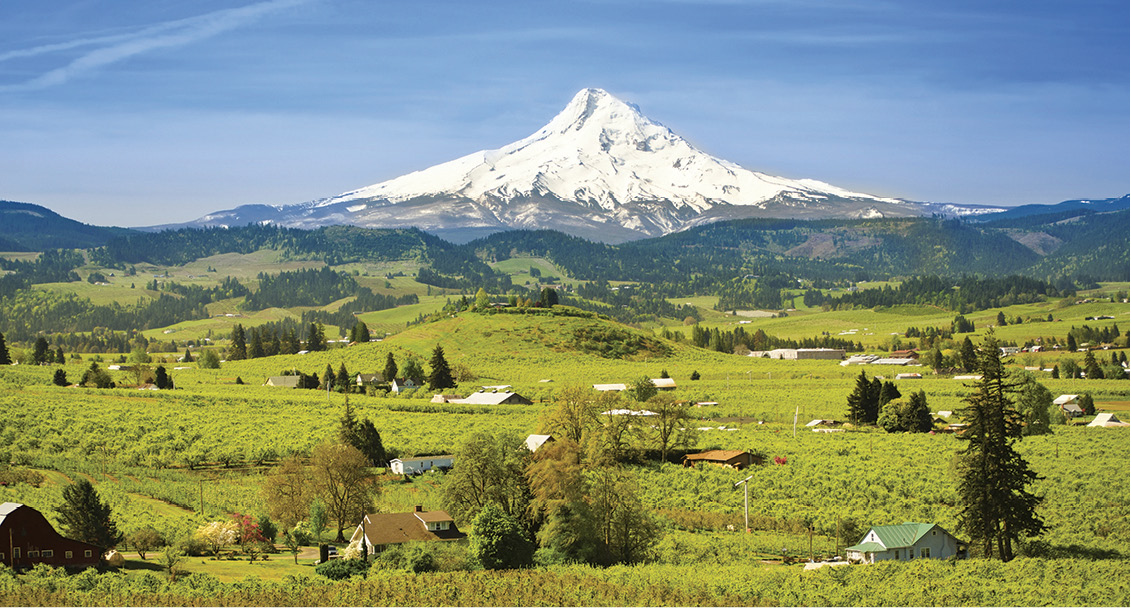
Snowcapped Mount Hood.
The Northwest’s version of the Grand Canyon is 85 miles of basalt cliffs, lofty waterfalls, lush forests, and, oh yes, the fourth-largest river in the U.S. Much of this National Scenic Area is still as wild as it was when Lewis and Clark paddled through. The Oregon side of the Gorge is a must-do day trip—or longer—from Portland. Combine it with Mt. Hood (p 140) for an even more impressive excursion. START: Troutdale, OR, 17 miles east of Portland.
❶ ★★★ Historic Columbia River Highway. The best (although not the fastest) way to experience the grandeur of the Columbia River Gorge is the way they did it in the days of Model Ts. Built between 1916 to 1926, the country’s first scenic highway was designed as a way for car travelers to enjoy the magnificent scenery, and it was considered one of the great engineering feats of its time. The narrow road winds for 70 miles along the southern side of the gorge, with dramatic climbs and descents and S-curves, past one amazing viewpoint, roaring waterfall, and 2,000-foot cliff to the next. Many of the original Florentine viaducts crafted by Italian stonecutters are still in place. Leave at least a few hours—better yet a whole day—from Troutdale to reach the Dalles (see p 147), or just Hood River (see p 145). If you’re in a hurry, I-84 also runs along the river. ☎ 541/308-1700. www.fs.usda.gov/crgnsa.
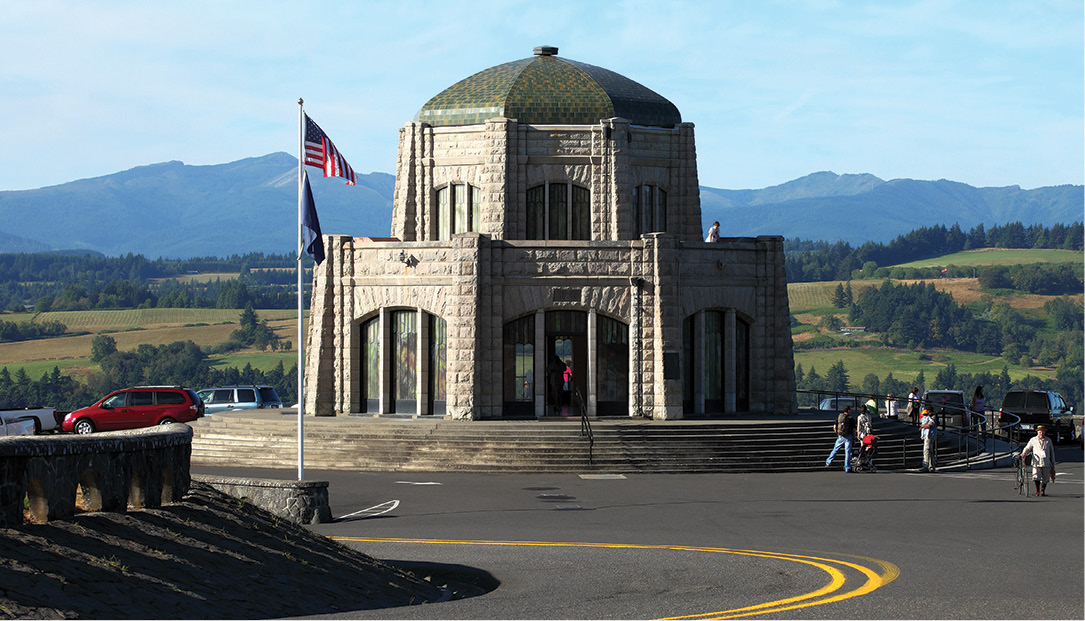
Vista House offers panoramic views of the Columbia River Gorge.
❷ ★★★ Crown Point and Vista House. If the Columbia Gorge had a headquarters, it would be at Crown Point, with its 30-mile views from atop a sheer 733-foot cliff. Here you’ll find the unmistakable octagonal Vista House, built in 1918 as an observatory and rest stop. Since then its resume has expanded to include a museum and gift shop, and it recently enjoyed a $3.2-million restoration. 3 miles east of Corbett on Historic Columbia River Hwy., I-84 exit 22. ☎ 503/695-2240. www.vistahouse.com. Vista House open 9am–6pm daily Apr–Oct; 10am–4pm Fri–Sun Nov–Mar, weather permitting. Free admission.
❸ ★  Bridal Veil Falls. Five miles east of Crown Point, Bridal Veil Creek tumbles down Larch Mountain and plunges into space, falling in two gauzy plumes for a total of 120 feet. Two trails leave from the picnic tables and restrooms at the parking lot. The short and easy lower trail heads down to the base, while a longer interpretive trail winds up to the lip of the falls, with log fences for the clumsy and agoraphobic. Both trails are under 1 mile round-trip. Milepost 28 on Historic Columbia River Scenic Highway, I-84 exit 28. Open daily dawn–dusk. Free admission. ☎ 800/551-6949.
Bridal Veil Falls. Five miles east of Crown Point, Bridal Veil Creek tumbles down Larch Mountain and plunges into space, falling in two gauzy plumes for a total of 120 feet. Two trails leave from the picnic tables and restrooms at the parking lot. The short and easy lower trail heads down to the base, while a longer interpretive trail winds up to the lip of the falls, with log fences for the clumsy and agoraphobic. Both trails are under 1 mile round-trip. Milepost 28 on Historic Columbia River Scenic Highway, I-84 exit 28. Open daily dawn–dusk. Free admission. ☎ 800/551-6949.
❹ ★★  Multnomah Falls. Oregon’s highest cascade, and the second-highest year-round waterfall in the country, plummets a total of 620 feet in two tiers at the bottom of Larch Mountain. It’s a majestic sight, even though its tourist must-see status can bring big crowds on weekends. The scene is enhanced, or at least not marred, by the graceful curve of the Benson Footbridge, built in 1914 about 100 feet over the lower falls. It’s part of a 1.2-mile trail that climbs 600 feet to the top of the upper falls, where an expansive panorama and the much smaller “Little Multnomah” waterfall await. Direct any questions to the information center inside the Multnomah Falls Lodge (below). I-84 exit 31. ☎ 503/ 695-2372. Open daily dawn–dusk; information center daily 9am–5pm. Free admission.
Multnomah Falls. Oregon’s highest cascade, and the second-highest year-round waterfall in the country, plummets a total of 620 feet in two tiers at the bottom of Larch Mountain. It’s a majestic sight, even though its tourist must-see status can bring big crowds on weekends. The scene is enhanced, or at least not marred, by the graceful curve of the Benson Footbridge, built in 1914 about 100 feet over the lower falls. It’s part of a 1.2-mile trail that climbs 600 feet to the top of the upper falls, where an expansive panorama and the much smaller “Little Multnomah” waterfall await. Direct any questions to the information center inside the Multnomah Falls Lodge (below). I-84 exit 31. ☎ 503/ 695-2372. Open daily dawn–dusk; information center daily 9am–5pm. Free admission.
Recharge with a bite at the historic  Multnomah Falls Lodge at the base of the falls, built in 1925. Look for an outdoor table in the summer, but don’t bother asking about overnight accommodations; there aren’t any. All meals daily. ☎ 503/695-2376. www.multnomahfallslodge.com. $$.
Multnomah Falls Lodge at the base of the falls, built in 1925. Look for an outdoor table in the summer, but don’t bother asking about overnight accommodations; there aren’t any. All meals daily. ☎ 503/695-2376. www.multnomahfallslodge.com. $$.
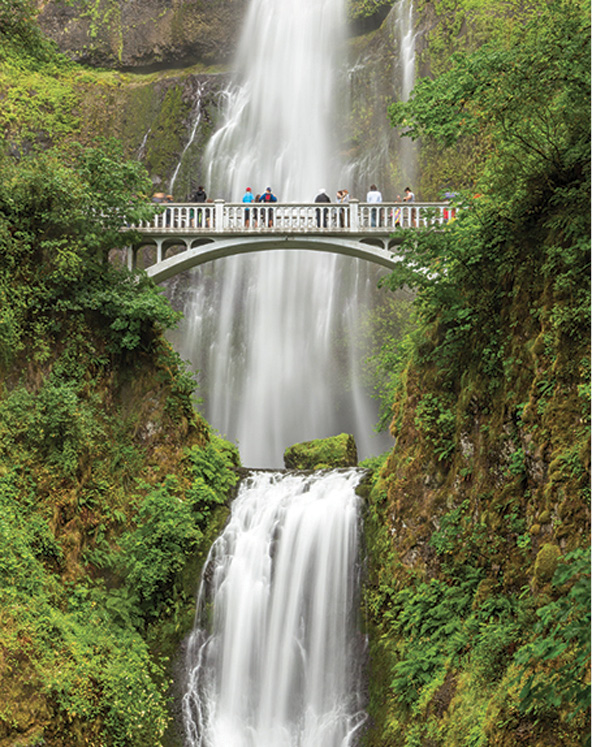
Multnomah Falls.
❻ ★★  Triple waterfall hike. With 77 cascades on the Oregon side of the Gorge (in case you were wondering, that’s Washington on the other side), picking which ones to visit can be tough. A relatively easy 4-mile loop trail hits no fewer than three, including an optional fourth, all without climbing over 800 feet. Start at the Horsetail Falls Trailhead on the Columbia River Highway. After ogling 176-foot Horsetail Falls, take Trail #400 up a mossy slope to reach 80-foot Ponytail Falls, which have undercut the hillside so much that the trail leads behind them. From here you’ll climb a bit farther to cross a bridge over the upper end of narrow Oneonta Gorge, before reaching a side trail (#438) that climbs almost a mile to Triple Falls, spilling over 100 feet into a large pool. Come back down to Trail #400 and take a left to descend to the Oneonta Gorge Trailhead. From here you can walk east along the highway half a mile back to your car—or else, if you’re properly outfitted with waterproof waders, and limber enough to climb over slippery fallen logs, take the stairs down into cool, deep Oneonta Gorge and wade upstream 1,000 feet to Oneonta Falls. Horsetail Falls Trailhead on the Columbia River Highway, 11⁄2 miles east of I-84 exit 35.
Triple waterfall hike. With 77 cascades on the Oregon side of the Gorge (in case you were wondering, that’s Washington on the other side), picking which ones to visit can be tough. A relatively easy 4-mile loop trail hits no fewer than three, including an optional fourth, all without climbing over 800 feet. Start at the Horsetail Falls Trailhead on the Columbia River Highway. After ogling 176-foot Horsetail Falls, take Trail #400 up a mossy slope to reach 80-foot Ponytail Falls, which have undercut the hillside so much that the trail leads behind them. From here you’ll climb a bit farther to cross a bridge over the upper end of narrow Oneonta Gorge, before reaching a side trail (#438) that climbs almost a mile to Triple Falls, spilling over 100 feet into a large pool. Come back down to Trail #400 and take a left to descend to the Oneonta Gorge Trailhead. From here you can walk east along the highway half a mile back to your car—or else, if you’re properly outfitted with waterproof waders, and limber enough to climb over slippery fallen logs, take the stairs down into cool, deep Oneonta Gorge and wade upstream 1,000 feet to Oneonta Falls. Horsetail Falls Trailhead on the Columbia River Highway, 11⁄2 miles east of I-84 exit 35.
❼ ★  Bonneville Lock and Dam. Completed in 1936 for hydropower and river navigation, this massive dam stretches 3,460 feet across the Columbia. Four sections connect both banks and three islands, one of which holds the Bradford Island Visitors Center, where you can watch through underwater windows as native salmon migrate upstream from October through December. (Fish ladders were added later.) The California sea lions that congregate at the base of the dam gobble so many fish that wildlife officials sometimes have to relocate them. Next to the dam, the Bonneville Fish Hatchery (☎ 541/374-8393) raises Chinook, Coho, and steelhead salmon and has display ponds where you can feed rainbow trout and white sturgeon. (Don’t miss 10-foot-long Herman the Sturgeon, who’s over 60 years old.) I-84 exit 40. ☎ 541/374-8820. www.nwp.usace.army.mil/locations. Visitor center open daily 9am–5pm; fish hatchery daily 7:30am–dusk. Free admission.
Bonneville Lock and Dam. Completed in 1936 for hydropower and river navigation, this massive dam stretches 3,460 feet across the Columbia. Four sections connect both banks and three islands, one of which holds the Bradford Island Visitors Center, where you can watch through underwater windows as native salmon migrate upstream from October through December. (Fish ladders were added later.) The California sea lions that congregate at the base of the dam gobble so many fish that wildlife officials sometimes have to relocate them. Next to the dam, the Bonneville Fish Hatchery (☎ 541/374-8393) raises Chinook, Coho, and steelhead salmon and has display ponds where you can feed rainbow trout and white sturgeon. (Don’t miss 10-foot-long Herman the Sturgeon, who’s over 60 years old.) I-84 exit 40. ☎ 541/374-8820. www.nwp.usace.army.mil/locations. Visitor center open daily 9am–5pm; fish hatchery daily 7:30am–dusk. Free admission.
❽ ★ Cascade Locks. A series of rapids kept steamboats from ascending the Columbia past this point until a series of locks were blasted from solid stone in 1896. Forty-two years later, most of them have disappeared beneath the rising waters of Lake Bonneville, behind Bonneville Dam. The upper locks are still above water, though, and are part of Cascade Locks Marine Park, with a visitor center, a small museum on river history, and the Oregon Pony, the first steam engine in the West. It’s the home base of the Columbia Gorge Sternwheeler (☎ 503/224-3900 or 800/224-3901; www.sternwheeler.com), a three-deck paddle-wheeler that gives tours of the gorge. You can cross to Washington on the Bridge of the Gods ($1 toll) named after a natural bridge that once stood here according to Native American legend. It’s open to cars and foot traffic, including hikers on the Pacific Crest Trail. I-84 exit 44. ☎ 541/374-8619. www.cascadelocks.net. Visitor center open May–Sept, hours vary; museum open Mon–Fri noon–5pm, Sat & Sun 10am–5pm May–Sept. Free admission.
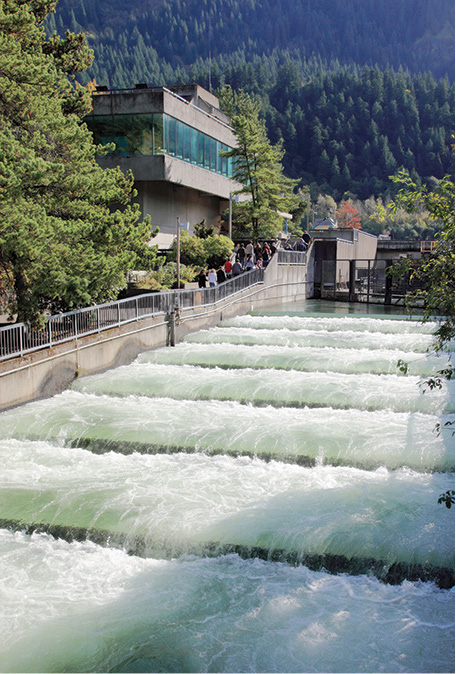
Fish ladder at Bonneville Dam.
❾ ★★ Hood River. The “Aspen of windsurfing” owes its worldwide reputation to the regular winds that rush down the gorge, sometimes topping 30mph in the summer. In fact, Hood River is an all-around adventure-sports hotspot, with kayaking, mountain biking, and hiking galore in the gorge and the nearby slopes of Mt. Hood. At night and on the rare calm day, there are plenty of shops and eateries to explore.
You can watch windsurfers and kiteboarders leap whitecaps from  The Hook, a short protected harbor, and the adjacent
The Hook, a short protected harbor, and the adjacent  Waterfront Park, both on the opposite (river) side of I-84 from town. If you’re inspired to give either a try, stop by
Waterfront Park, both on the opposite (river) side of I-84 from town. If you’re inspired to give either a try, stop by  Windance Sailboards (108 Hwy. 35 at Hwy. 30; ☎ 541/386-2131; www.windance.com) for rentals and lessons. (Keep in mind that learning here is like learning to drive in Manhattan: difficult, but then you’re ready for anything.) To take on one of the many mountain-bike trails on the flanks of Mt. Hood to the south, head to
Windance Sailboards (108 Hwy. 35 at Hwy. 30; ☎ 541/386-2131; www.windance.com) for rentals and lessons. (Keep in mind that learning here is like learning to drive in Manhattan: difficult, but then you’re ready for anything.) To take on one of the many mountain-bike trails on the flanks of Mt. Hood to the south, head to  Discover Bicycles (210 State St.; ☎ 541/386-4820; www.discoverbicycles.com) for tips and the largest rental selection in the Northwest. The bulk of the town’s restaurants are on or near Oak Street (U.S. 30), including
Discover Bicycles (210 State St.; ☎ 541/386-4820; www.discoverbicycles.com) for tips and the largest rental selection in the Northwest. The bulk of the town’s restaurants are on or near Oak Street (U.S. 30), including  Celilo Restaurant and Bar (16 Oak St.; ☎ 541/386-5710; www.celilorestaurant.com) and
Celilo Restaurant and Bar (16 Oak St.; ☎ 541/386-5710; www.celilorestaurant.com) and  Kaze Sushi (212 4th St.; ☎ 541/387-0434). One notable exception is the
Kaze Sushi (212 4th St.; ☎ 541/387-0434). One notable exception is the  Full Sail Tasting Room & Pub (506 Columbia St.; ☎ 541/386-2247; www.fullsailbrewing.com), one of Oregon’s first and most famous craft breweries. If all this makes you want to spend the night, the 100-year-old
Full Sail Tasting Room & Pub (506 Columbia St.; ☎ 541/386-2247; www.fullsailbrewing.com), one of Oregon’s first and most famous craft breweries. If all this makes you want to spend the night, the 100-year-old  Hood River Hotel (102 Oak St.; ☎ 800/386-1859; www.hoodriverhotel.com) is the city’s oldest and one of its best.
Hood River Hotel (102 Oak St.; ☎ 800/386-1859; www.hoodriverhotel.com) is the city’s oldest and one of its best.
❿ ★★  Hood River Valley Fruit Loop. The river valley between the Columbia and Mt. Hood packs a lot into a small and scenic area: wineries, beehives, lavender farms, and 2.4 million fruit trees, almost a quarter of Oregon’s total. (It’s the country’s top pear-growing district.) A 35-mile loop drive along Hwy. 281 and Hwy. 35, through the burgs of Dee, Odell, Oak Grove, Pine Grove, and Mount Hood, is a wonderful way to spend a day meandering from one farm, roadside produce stand, and alpaca ranch to another. (An organized driving route counts 36 stops.) Many farms let you pick your own fruit, and festivals from spring through fall celebrate what’s in season, from cherries in July to pumpkins in November. Maps and information at Hood River visitor center, I-84 exit 64. ☎ 541/386-2000 or 800/366-3530. www.hoodriverfruitloop.com. Fruit tree blossoms peak in Apr, fall foliage in Oct.
Hood River Valley Fruit Loop. The river valley between the Columbia and Mt. Hood packs a lot into a small and scenic area: wineries, beehives, lavender farms, and 2.4 million fruit trees, almost a quarter of Oregon’s total. (It’s the country’s top pear-growing district.) A 35-mile loop drive along Hwy. 281 and Hwy. 35, through the burgs of Dee, Odell, Oak Grove, Pine Grove, and Mount Hood, is a wonderful way to spend a day meandering from one farm, roadside produce stand, and alpaca ranch to another. (An organized driving route counts 36 stops.) Many farms let you pick your own fruit, and festivals from spring through fall celebrate what’s in season, from cherries in July to pumpkins in November. Maps and information at Hood River visitor center, I-84 exit 64. ☎ 541/386-2000 or 800/366-3530. www.hoodriverfruitloop.com. Fruit tree blossoms peak in Apr, fall foliage in Oct.
Mount Hood Railroad
Experience a bit of time travel aboard a 1906-era railroad through the Hood River Valley. Started as a freight line, it still pulls the occasional freight car but is mostly used for scenic tours to Odell (2 hr. round-trip) and Parkdale (4 hr. round-trip). It’s worth it to splurge for the upper dome car, and pack a lunch for the short stopovers. Along the way you’ll get views of Mt. Hood and the gorge, and experience one of the few switchback tracks still in use in the U.S. Special tours throughout the year range from brunch and Murder Mystery dinner trains to Western Robbery rides and a holiday Polar Express. ☎ 800/872-4661. www.mthoodrr.com. Trains run year-round Tues–Sun, schedule varies, regular excursions $30–$55 adults, $25–$35 children, meal trains and special excursions $30–$82 per person.
⓫ ★ The Dalles. The eastern end of the Columbia River Highway is a historic city at one of the few spots along the river where early traders could load boats and Oregon Trail pioneers could raft their way to Oregon City, the end of the trail. It’s full of 19th-century buildings and more recent murals. The Fort Dalles Museum (500 W. 15th St.; ☎ 541/296-4547; www.fortdallesmuseum.org), Oregon’s oldest, occupies the surgeon’s quarters of an 1856 fort. In the mid-1800s, Methodist missionaries preached to Native Americans from Pulpit Rock, still standing at 12th and Court streets.
⓬ ★★ Columbia Gorge Discovery Center and Museum. Everything you ever wanted to know about the gorge, from the Ice Age and Lewis and Clark through the finer points of how to windsurf, comes together in this exceptional museum. The wide-windowed building itself is a wonder, and its collection spans geology, natural history, and 12,000 years of human habitation, with films, photos, and artifacts. Living history exhibits and a live raptor program round out the experience. Outside, a paved trail connects wetlands, a pond, and viewpoints of the gorge, and continues 4.5 miles to the Dalles. 5000 Discovery Dr. ☎ 541/296-8600. www.gorgediscovery.org. Open daily 9am–5pm. Admission $9 adults, $7 seniors, $5 children 6–16, free for 6 and under.
The fertile, sheltered valley of the Willamette (“wih-LAM-it”) River, the “promised land” for so many settlers on the Oregon Trail, is now one of the country’s top winegrowing regions. It’s a kind of anti-Napa, with little of the pretentiousness or crowds, although summer weekends can get very busy. Pinot noir is gospel here, but you’ll find other cool-weather vintages as well, including pinot gris, Rieslings, Gewürztraminers, and ever-improving chardonnays. You’ll also find roadside produce stands and farms growing everything from tulips to hazelnuts. (Be warned: Hwy. 99W can get choked with traffic on weekends, so consider an alternate route.) START: U.S. 26 west to OR 47, about 27 miles from Portland to Forest Grove.
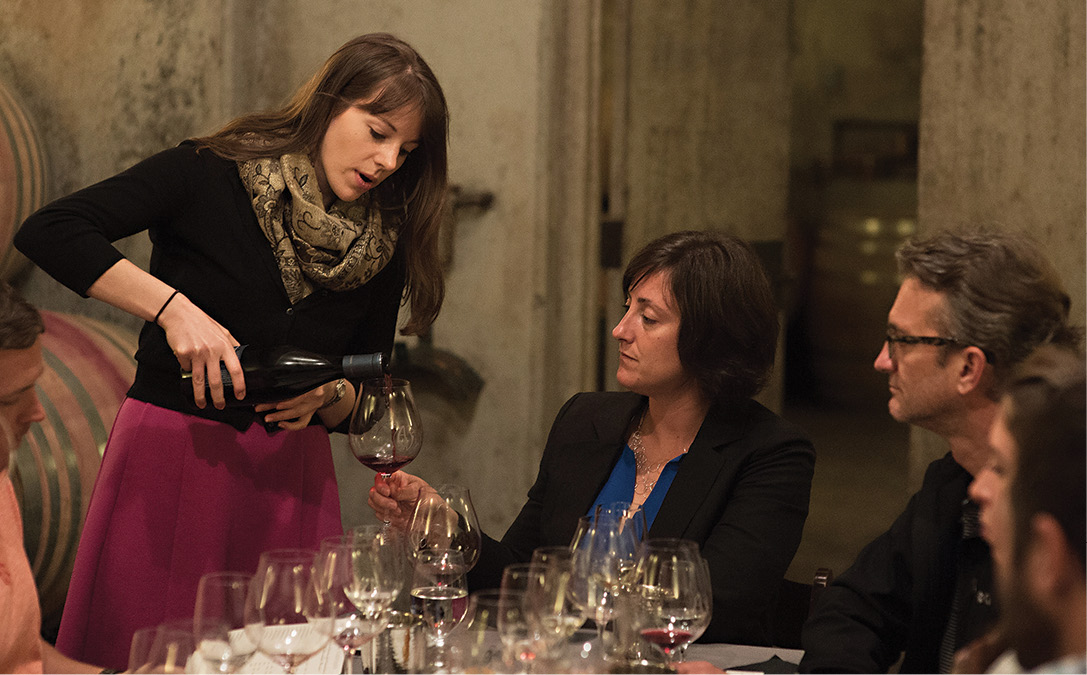
Wine tasting at Adelsheim Vineyard.
❶ ★ McMenamins Grand Lodge. One of the, well, grandest properties in the McMenamins portfolio, this 1922 retirement home is full of all the kaleidoscopic artwork, comfy lounges, and craft beer you’d expect, along with a wine bar, spa, movie theater, soaking pool, and four on-site choices for food and libations. There’s even a disc golf course on the expansive lawns that surround the property. The less expensive guestrooms have shared bathrooms. 3505 Pacific Ave., Forest Grove. ☎ 877/922-9533 or 503/992-9533. www.mcmenamins.com/GrandLodge. Rooms $65–$175 double. AE, MC, V.
❷ ★ SakéOne. Leave it to Oregon to have the only American-owned craft sake brewery in the world. After a tour of the facilities, head to the tasting room to sample their popular blue-bottled Momokawa line, as well as the fruit-infused Moonstone and undiluted “G” brands. 820 Elm St. off OR 47, Forest Grove. ☎ 800/550-SAKE (7253) or 503/357-7056. www.sakeone.com. Tasting room open daily 11am–5pm; tasting flights $5–$15 per person.
❸ ★ Adelsheim Vineyard. One of Oregon’s most popular pinot noir producers, Adelsheim has a big tasting room and a patio overlooking the vineyard. Tastings aren’t cheap, but you can sample vintages that aren’t on the market—including some outstanding single-vineyard wines—and the fee goes toward purchases. 16800 NE Calkins Lane, Newberg. ☎ 503/538-3652. www.adelsheim.com. Tasting room open daily 11am–4pm. Fee $15. Tour by appointment only.
Guided Wine Tours
If you can’t tell a pinot noir from a petite Syrah—or if you just don’t want to have to pick a designated driver—try an in-depth guided tour of Willamette wine country. Grape Escape (☎ 503/283-3380; www.grapeescapetours.com) runs outings with highly trained guides that include pick-up and drop-off, food and tasting at three wineries in a day ($155 per person for three people; less for larger groups, for half-day tour). Oregon Wine Tours (☎ 503/681-WINE [9463]; www.orwinetours.com) do the same, with themed excursions such as small producers and “ABP” (“Anything But Pinot”). Their all-day tours start at $375 per person for one or two people).
❹ ★★ Penner-Ash Wine Cellars. It’s a bit tricky to find, but winemaker Lynn Penner-Ash’s winery offers outstanding vintages and wonderful views from a hilltop between Yamhill and Newberg. The pinot noirs and Syrahs are deservedly famous, but they also make viogniers, rubeos, Rieslings, and rosés. 15771 NE Ribbon Ridge Rd., Newberg. ☎ 503/554-5545. www.pennerash.com. Tasting room open Wed–Sun 11am–5pm. Fees $15.Tour by appointment only.
Anyone who’s on a gluten-free diet will be happy to stop in at  Bella Luna Gluten-Free Patisserie & Chocolate Shop for a gluten-free sweet. 185 S. Maple St., Yamhill, OR. ☎ 503/662-0098. www.bellalunapatisserie.com. $.
Bella Luna Gluten-Free Patisserie & Chocolate Shop for a gluten-free sweet. 185 S. Maple St., Yamhill, OR. ☎ 503/662-0098. www.bellalunapatisserie.com. $.
❻ ★★ Carlton Winemakers Studio. Eleven vintners banded together here under one roof offer tastings of up to 40 different wines. If you’re pressed for time or just like to sample a wide range, it’s a good choice to visit. The modern building was the first in the country to be certified by the U.S. Green Building Council. 801 N. Scott St., Carlton. ☎ 503/852-6100. www.winemakersstudio.com. Tasting room open daily 11am–5pm. Fee $5–$20.
Stock up for your winery picnic lunch at  Harvest Fresh Grocery & Deli, a natural food store offering local produce, sandwiches, salads, and fresh-squeezed juices and smoothies. 251 NE 3rd St., McMinnville. ☎ 503/472-5740. www.harvestfresh.com. $.
Harvest Fresh Grocery & Deli, a natural food store offering local produce, sandwiches, salads, and fresh-squeezed juices and smoothies. 251 NE 3rd St., McMinnville. ☎ 503/472-5740. www.harvestfresh.com. $.
❽ ★ McMinnville. Amble down 3rd Street, “Oregon’s Favorite Main Street,” to find local shops, boutiques, wine-tasting rooms, and top-notch restaurants. Bon Appétit magazine dubbed McMinnville one of the country’s best small towns for food lovers, and you can see why at places like Thistle (228 NE Evans St.; ☎ 503/472-9623; www.thistlerestaurant.com) and Bistro Maison (729 NE 3rd St.; ☎ 503/474-1888; www.bistromaison.com). Even the breakfast spots are four-star: Try the pork meatloaf at the Crescent Café (526 NE 3rd St.; ☎ 503/435-2655; www.crescentcafeonthird.com). The rooftop bar and deck at the McMenamins Hotel Oregon (310 NE Evans St.; ☎ 888/472-8427 or 503/472-8427; www.mcmenamins.com/HotelOregon) is a perfect stop at the end of a wine tour day. (The tater tots are a guilty pleasure.)
❾ ★★★  Evergreen Aviation and Space Museum. In between bites of brie and sips of Syrah, how about a side trip to see the largest plane ever built? Howard Hughes’s “Spruce Goose,” a wooden flying boat with a 320-foot wingspan, flew exactly once, for 1 minute, before ending up at this hangarlike museum alongside fighter jets, stunt planes, a Mercury space capsule, and much more. There’s also an IMAX theater and a waterpark with a wave pool and ten waterslides—including four that start from inside a real 747 plopped on the roof. 500 NE Capt. Michael King Smith Way, McMinnville. ☎ 503/434-4185. www.evergreenmuseum.org. Museum admission $25 adults, $24 seniors over 63, $23 children 5–16, free for children under 5. Waterpark admission $32, or $27 if under 42 inches tall. Museum open daily 9am–5pm; waterpark daily 10am–8pm.
Evergreen Aviation and Space Museum. In between bites of brie and sips of Syrah, how about a side trip to see the largest plane ever built? Howard Hughes’s “Spruce Goose,” a wooden flying boat with a 320-foot wingspan, flew exactly once, for 1 minute, before ending up at this hangarlike museum alongside fighter jets, stunt planes, a Mercury space capsule, and much more. There’s also an IMAX theater and a waterpark with a wave pool and ten waterslides—including four that start from inside a real 747 plopped on the roof. 500 NE Capt. Michael King Smith Way, McMinnville. ☎ 503/434-4185. www.evergreenmuseum.org. Museum admission $25 adults, $24 seniors over 63, $23 children 5–16, free for children under 5. Waterpark admission $32, or $27 if under 42 inches tall. Museum open daily 9am–5pm; waterpark daily 10am–8pm.
❿ ★★ Sokol Blosser Winery. Whites are the favorites at this popular Dundee winery, the first in the country to receive LEED certification for sustainable practices. Tour the vineyards in a custom biodiesel ATV to see organic farming techniques and a 24kW solar array in action. 5000 Sokol Blosser Lane, Dundee. ☎ 800/582-6668 or 503/864-2282. www.sokolblosser.com. Tasting room open daily 10am–4pm. Fee $15. Tours by appointment only.
⓫ ★★ Allison Inn & Spa. The only high-end getaway in Wine Country makes an excellent base for wine touring. Rooms are huge, with HDTVs and (in some) hot tubs, and the lush grounds are perfect for strolling and sipping your latest purchase. Relax in the spa and enjoy topnotch wine-country cuisine at the Jory restaurant. What really earns raves, though, is the attentive but unobtrusive service. 2525 Allison Lane, Newberg. ☎ 503/554-2525. www.theallison.com. Rooms $375–$405.
The northern part of Oregon’s coastline gets the most visitors, and it’s easy to see why: The thickly forested Coast Range mountains meet the crashing waves of the Pacific in towering headlands and wide, flat beaches punctuated by towering, offshore rock monoliths. Yes, it’s too cold to swim without a wet suit; but summers are uncrowded by California or East Coast standards, and winter brings its own stormy beauty—plus migrating gray whales. And thanks to a forward-thinking 1967 law, all of Oregon’s breathtaking coastline is forever public. START: U.S. 30 West from Portland, 100 miles.
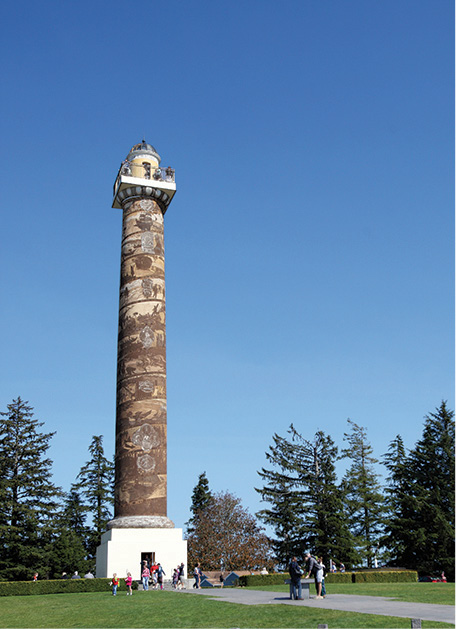
Astoria Column tops Coxcomb Hill.
❶ ★★ Astoria. The oldest American settlement west of the Mississippi was founded as Fort Astoria in 1811 by fur trappers working for John Jacob Astor, America’s first multimillionaire. Today, restored Victorian homes pepper the hillsides, and restaurants, art galleries, and shops are revitalizing the dilapidated downtown. Spend an afternoon strolling the riverwalk, watching cruise ships and barges pass and sea lions lounge on piers. While you’re there, grab a vegetarian crepe or a plate of local seafood at the charming Columbian Café (1114 Marine Dr.; ☎ 503/325-2233; www.columbianvoodoo.com). For more of a workout, climb the staircase inside the 125-foot-high Astoria Column atop Coxcomb Hill for a panoramic view. Don’t miss the outstanding Columbia River Maritime Museum (1792 Marine Dr.; ☎ 503/325-2323; www.crmm.org), with exhibits on the history of the country’s second-largest river and the wreck-strewn “Graveyard of the Pacific” at its mouth. If you’re inspired to stay, the Cannery Pier Hotel (10 Basin St.; ☎ 888/325-4996 or 503/325-4996; www.cannerypierhotel.com) is a modern luxury hotel built on an old cannery pier stretching 600 feet out in the river. www.astoriaoregon.com.
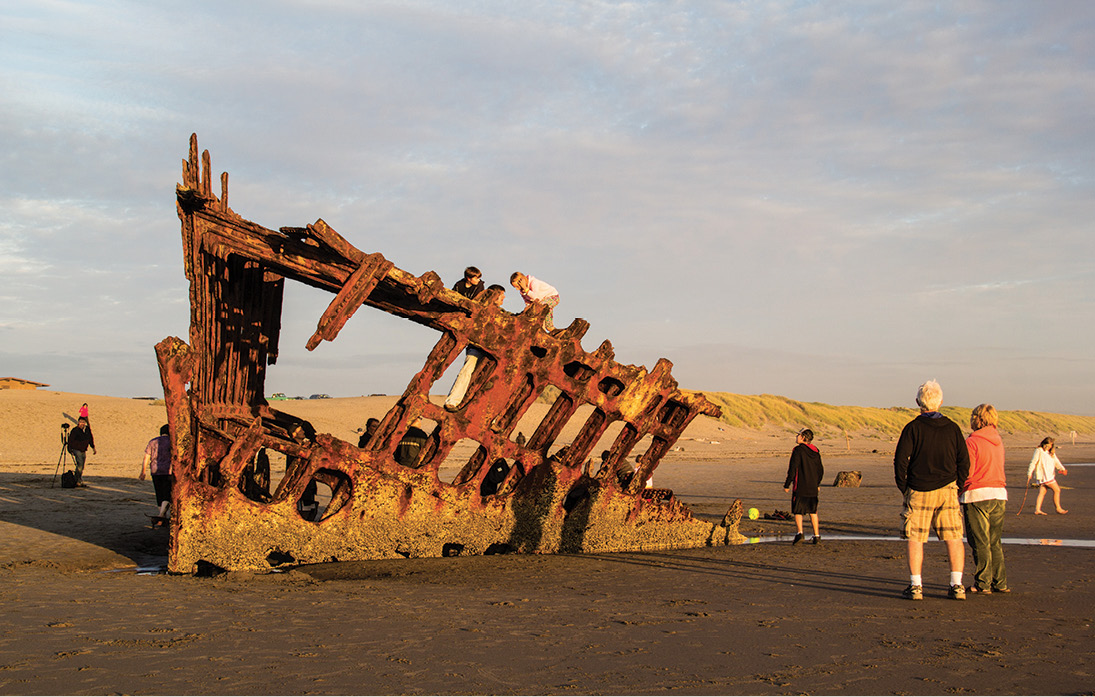
The wreck of the Peter Iredale, in Fort Stevens State Park.
❷ ★ Fort Stevens State Park. This 4,200-acre park in Oregon’s far northwestern corner is guarded by a fort built during the Civil War to protect the mouth of the Columbia River. It was the only military installation in the continental U.S. to be fired on by the Japanese during World War II—17 shells in June 1942, to be exact. Now it consists of a military museum surrounded by huge concrete bunkers and paths for hiking and bicycling. There’s also a lake for swimming and a large campground with yurts and cabins. Head to the park’s Pacific beach to find the rusted wreck of the Peter Iredale, a four-masted steel sailboat that ran ashore on October 25, 1906. Living history events happen from April to September, including a Civil War reenactment over Labor Day weekend. 8 miles from Astoria via U.S. 101 & Ridge Rd. ☎ 503/861-1671 or 800/551-6949. www.oregonstateparks.org/park_179.php. Museum open 10am–6pm summer and fall; 10am–4pm winter and spring. Admission $5 per car. Campsites $21; yurts $55; cabins $89–$99.
❸ ★★★  Fort Clatsop—Lewis and Clark National Historic Park. After slogging across half of North America, Lewis and Clark spent the cold, rainy winter of 1805–06 holed up in a log stockade they built near present-day Astoria. Named after the friendly local Clatsop Indians, the reconstructed fort is part of the Lewis and Clark National and State Historical Parks group. The primitive buildings give an accurate and atmospheric picture of the conditions at the fort over 200 years ago. In the summer, costumed interpreters demonstrate frontier-era skills such as making candles and shooting a flintlock rifle. From here the 6.5-mile Fort to Sea Trail leads through forest, dunes, and fields to Sunset Beach State Recreation Area. Off U.S. 101, 5 miles southwest of Astoria. ☎ 503/861-2471. www.nps.gov/lewi. Admission $5 adults, free for ages 16 and under. Mid-June to Labor Day daily 9am–6pm; Labor Day to mid-June daily 9am–5pm.
Fort Clatsop—Lewis and Clark National Historic Park. After slogging across half of North America, Lewis and Clark spent the cold, rainy winter of 1805–06 holed up in a log stockade they built near present-day Astoria. Named after the friendly local Clatsop Indians, the reconstructed fort is part of the Lewis and Clark National and State Historical Parks group. The primitive buildings give an accurate and atmospheric picture of the conditions at the fort over 200 years ago. In the summer, costumed interpreters demonstrate frontier-era skills such as making candles and shooting a flintlock rifle. From here the 6.5-mile Fort to Sea Trail leads through forest, dunes, and fields to Sunset Beach State Recreation Area. Off U.S. 101, 5 miles southwest of Astoria. ☎ 503/861-2471. www.nps.gov/lewi. Admission $5 adults, free for ages 16 and under. Mid-June to Labor Day daily 9am–6pm; Labor Day to mid-June daily 9am–5pm.
❹ ★ Gearhart. If your goal is to get away from it all, even by Oregon Coast standards, then this tiny beach town is for you. Beyond a scant handful of tourist-oriented businesses, Gearhart is just private homes—expensive ones—and a nearly deserted 4-mile stretch of beach. At the Gearhart Ocean Inn (67 N. Cottage Ave.; ☎ 503/738-7373; www.gearhartoceaninn.com), you can steam your own clams in the kitchenettes or walk across the street to the cozy Pacific Way Bakery & Café (601 Pacific Way; ☎ 503/738-0245) for a croissant or French dip sandwich. Next door is Pop’s Sweet Shop (567 Pacific Way; ☎ 503/738-8484), serving dozens of flavors of Tillamook ice cream. Head to the end of Wellington Street at the south end of town to find a short, unmarked trail to the Necanicum River estuary, often packed with shore birds stalking the mudflats for dinner. From here, the Pacific dunes are just a short walk west.
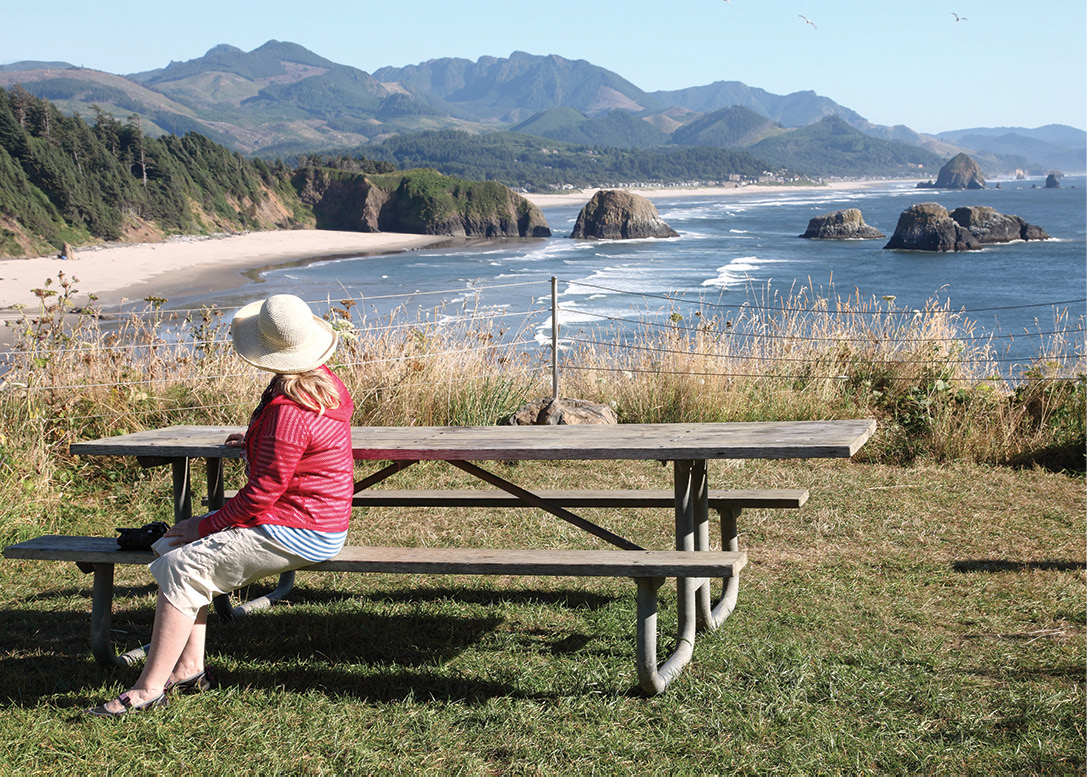
Coastline views in Ecola State Park.
❺ ★  Seaside. Oregon’s version of the Jersey Shore brings a little tacky fun to the otherwise staid beach towns around here. The town itself is full of historic cottages dating to the turn of the 20th century, but what draws most visitors is the wide white-sand beach and the 2-mile beachfront promenade, lined with souvenir shops, video arcades, minigolf courses, and amusement-park rides. Lifeguards are on duty throughout the summer, making this a popular beach with families. There are plenty of places to buy kites or rent three- and four-wheeled beach cycles. At the Seaside Aquarium (200 N. Promenade; ☎ 503/738-6211; www.seasideaquarium.com), one of the oldest on the West Coast, you can touch a sea anemone or feed a seal. 80 miles from Portland via U.S. 26. www.seasideor.com.
Seaside. Oregon’s version of the Jersey Shore brings a little tacky fun to the otherwise staid beach towns around here. The town itself is full of historic cottages dating to the turn of the 20th century, but what draws most visitors is the wide white-sand beach and the 2-mile beachfront promenade, lined with souvenir shops, video arcades, minigolf courses, and amusement-park rides. Lifeguards are on duty throughout the summer, making this a popular beach with families. There are plenty of places to buy kites or rent three- and four-wheeled beach cycles. At the Seaside Aquarium (200 N. Promenade; ☎ 503/738-6211; www.seasideaquarium.com), one of the oldest on the West Coast, you can touch a sea anemone or feed a seal. 80 miles from Portland via U.S. 26. www.seasideor.com.
❻ ★★★ Ecola State Park. Lewis and Clark arrived here in 1806—the farthest south they ventured on the Oregon coast—to buy whale blubber and see a whale washed up on the beach. Their 16-year-old Indian guide, Sacagawea, was in the scouting party. You can trace part of their route on a 2.5-mile loop trail through steep forests of Sitka spruce, or take a slightly longer trail 600 feet up to the top of Tillamook Head, which Clark called “the steepest worst & highest mountain I ever ascended.” (It’s not that bad, and the views of the coastline are more than worth it.) More hiking trails lead to the beach, a primitive hike-in campsite, and picnic areas on high bluffs, perfect for spotting whales in the winter and spring—and surfers year-round. Just north of Cannon Beach on U.S. 101. ☎ 800/551-6949 or 503/436-2844. www.oregonstateparks.org/park_188.php. Fee $5 per vehicle.
❼ ★★★ Cannon Beach. Named for a cannon that washed ashore from a shipwreck in 1846, Cannon Beach may be the prototypical Oregon coast town, full of homes covered in weathered cedar shingles, plus art galleries, shops, and good restaurants and hotels. Visitors pack the place in the summer, but it hasn’t turned into a northwest Carmel-by-the-Sea quite yet. Iconic Haystack Rock is a 235-foot-high sea stack (formed by wave erosion) just off the beach, home to sea birds like tufted puffins. It’s surrounded by tide pools full of life—just don’t get stranded by the rising tide. Follow up an intimate seafood dinner at Newmans at 988 (988 S. Hemlock St.; ☎ 503/436-1151; www.newmansat988.com) with a night at the Stephanie Inn (2740 S. Pacific St.; ☎ 800/633-3466 or 503/436-2221; www.stephanie-inn.com), regularly listed among the most romantic in Oregon. The Inn at Cannon Beach (3215 S. Hemlock St.; ☎ 800/321-6304; www.atcannonbeach.com) is off the main drag but near the beach, with oceanfront balcony rooms overlooking Haystack Rock. 80 miles from Portland via U.S. 26. www.cannonbeach.org.
Enjoy a marionberry scone at  Lazy Susan Café. This two-story Cannon Beach cottage is one of the best breakfast spots in town. They’re also open for lunch and dinner, with salads, sandwiches, and seafood stews. 126 N. Hemlock St. ☎ 503/436-2816. $. No credit cards.
Lazy Susan Café. This two-story Cannon Beach cottage is one of the best breakfast spots in town. They’re also open for lunch and dinner, with salads, sandwiches, and seafood stews. 126 N. Hemlock St. ☎ 503/436-2816. $. No credit cards.
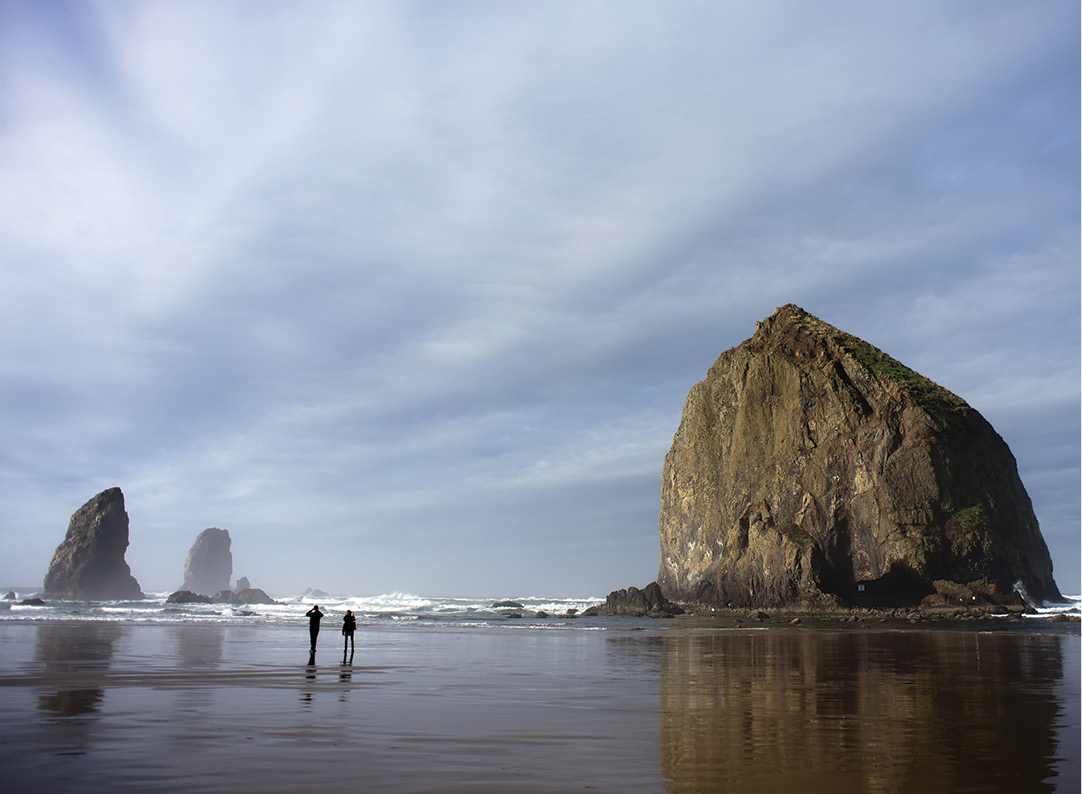
Cannon Beach’s iconic Haystack Rock.
❾ ★★ Oswald West State Park. Mountains meet the sea in a show-stopping way at this coastal park. A 15-minute hike to the secluded, crescent-shaped beach keeps out most of the crowds, except for surfers, who love the constant waves. More trails lead to viewpoints from the headlands on either side, and the Oregon Coast Trail goes up and over 1,600-foot Neahkahnie Mountain. Translated as “place of the supreme deity” in the native Tillamook language, the mountain is reputed to hide a lost Spanish fortune that has cost more than one treasure-hunter’s life. One trailhead is just south of the park boundary on U.S. 101. From there, it’s 2 steep miles through dense forest to the summit. 10 miles south of Cannon Beach. ☎ 800/551-6949. www.oregonstateparks.org/park_195.php. Fee $5 per vehicle.
❿ ★★★ Manzanita. A favorite getaway on the northern Coast, this 600-person village has one main street and not much to do besides eat, sleep, and go to the beach. It’s close enough to Cannon Beach and numerous state parks to enjoy those by day, but all you can hear at night are the waves. The Ocean Inn at Manzanita (32 Laneda Ave.; ☎ 866/368-7701 or 503/368-7701; www.oceaninnatmanzanita.com) has 10 condo and kitchenette units right on the sand, and the Coast Cabins (635 Laneda Ave.; ☎ 800/435-1269 or 503/368-7113; www.coastcabins.com) are five cedar cottages with a Japan-meets-Scandinavia aesthetic. The Bread and Ocean Bakery (154 Laneda Ave.; ☎ 503/368-5823; www.breadandocean.com) is one of the better lunch and dinner places in town, with great cinnamon rolls and sandwiches. 141⁄2 miles south of Cannon Beach on U.S. 101. www.exploremanzanita.com.
⓫ ★ Nehalem Bay State Park. This park covers most of the sandy spit separating Nehalem Bay and the mouth of the Nehalem River from the ocean. You’ll find a campground, rental yurts, and paths for horses, bikes, and joggers. In summer, guided horseback rides are available for anywhere from 1 hour to all day. Or go crabbing, fishing, or sailing around the calm waters of the bay, paddle a sea kayak upriver, or head offshore for surfing or windsurfing. Some parts of the beach may be closed to protect nesting seabirds. ☎ 503/368-5154 or 800/551-6949. www.oregonstateparks.org/park_201.php. Fee $5 per car; yurts $44–$54; horseback rides $70–$150 per person for 1–2 hours, full day $400.
After a tour of  Tillamook Cheese Factory, which produces 167,000 pounds of cheese every day, you can sample the goods at the attached store, including cheese curds (aka “squeaky cheese”), ice cream, and fudge. 4175 Hwy. 101 N. ☎ 800/542-7290 or 503/815-1300. www.tillamook.com/cheese-factory. $.
Tillamook Cheese Factory, which produces 167,000 pounds of cheese every day, you can sample the goods at the attached store, including cheese curds (aka “squeaky cheese”), ice cream, and fudge. 4175 Hwy. 101 N. ☎ 800/542-7290 or 503/815-1300. www.tillamook.com/cheese-factory. $.
⓭ ★  Tillamook Air Museum. More than 30 restored vintage planes and helicopters have found a home in the world’s largest free-standing wooden building, a former World War II Navy blimp hangar that stands over 15 stories high. The collection includes a P-38 Lightning, a P51-Mustang, and a Bf-109 Messerschmitt. 6030 Hangar Rd. ☎ 503/842-1130. www.tillamookair.com. Admission $9 adults, $8 seniors over 63, $5 youth 5–17, free for 5 and under. Open daily 9am–5pm.
Tillamook Air Museum. More than 30 restored vintage planes and helicopters have found a home in the world’s largest free-standing wooden building, a former World War II Navy blimp hangar that stands over 15 stories high. The collection includes a P-38 Lightning, a P51-Mustang, and a Bf-109 Messerschmitt. 6030 Hangar Rd. ☎ 503/842-1130. www.tillamookair.com. Admission $9 adults, $8 seniors over 63, $5 youth 5–17, free for 5 and under. Open daily 9am–5pm.
⓮ ★★★ Three Capes Scenic Loop. Perhaps the prettiest drive on this part of the coast, this 30-mile route takes you from Tillamook to Pacific City, past view after view of the rugged coast. Take 3rd Street out of Tillamook toward the ocean and turn right on Bayocean Road to reach Cape Meares State Scenic Viewpoint, home to Oregon’s largest Sitka spruce and the Cape Meares Lighthouse (☎ 503/842-2244; www.capemeareslighthouse.org). The 200-foot-high headland is the only place in the U.S. where you can see three National Wildlife Refuges at once: Cape Mears, Oregon Islands, and Three Arch Rocks. Look for peregrine falcons and gray whales in the winter. Keep going to Cape Lookout State Park (☎ 503/842-4981 or 800/551-6949; www.oregonstateparks.org/park_186.php), where a 2.5-mile trail winds through dense old-growth rainforest to the tip of the peninsula, a great place to spot gray whales. There’s also a campground (sites $21) with yurts ($44–$54), cabins ($98) and a $5 entry fee per car. Past Oceanside and Netarts Bay, Cape Kiwanda State Natural Area (☎ 800/551-6949; www.oregonstateparks.org/park_180.php) consists of sea cliffs, a beach, and a giant sand dune popular with hang gliders. Another giant sea stack looms offshore. •